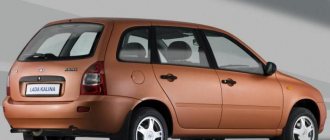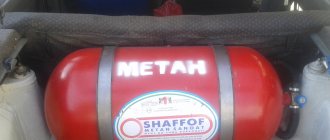Two years ago, a new product from the domestic AvtoVAZ, the Lada Vesta with a robotic gearbox, went on sale. The engineers abandoned the classic torque converter (Jatco JF414E) due to its high cost and lack of a production platform for maintenance.
AMT - this is how “robot” is designated; it was developed by the domestic design bureau of AvtoVAZ based on the mechanical type of ZF class gearbox. Of course, in terms of gear shift speed, AMT is inferior to foreign analogues from Europe and America, but it looks quite decent on the Russian market.
LADA Vesta is equipped with AMT paired with a 1.6-liter / 106-horsepower and 1.8-liter / 122-horsepower power unit. The price per copy varies from 640,000 to 850,000 rubles. AMT is also installed on Vesta SW and LADA Vesta Cross with an engine capacity of 1.8 liters. Starting price from 705,000 rubles.
Reviews from car owners
| № | Positive |
| 1. | Vladimir , 37 years old (drive2.ru): I like the AMT on the Lada Vesta, it’s better than the manual one. It's unusual to control gears with the gas pedal. The harder you press the accelerator, the lower the gear becomes. To change to increased speed after a kickdown, release the pedal a little. In general, you need to get used to it. At first I was confused about what and how. Once I almost collided with the vehicle in front. |
| 2. | Dmitry , 42 years old (prom.ua): I bought Vesta last year with AMT. I had some doubts about the correctness of my choice, but overall I am pleased with the results of a year of operation. Shifts are not the fastest, but quite tolerable. The torque converter in the first models had better smoothness. I had a chance to drive old versions of Vesta. On the highway, the car is economical, rides smoothly, quickly picks up speed, and is maneuverable when overtaking. I drove 17,000 km without capital investments, repairs, only scheduled maintenance. My review of the Lada Vesta automatic is only positive. |
| 3. | Alexey , 38 years old (drom.ru): The first few hundred kilometers the impressions were incomprehensible. I haven’t encountered AMT before, only manual and CVT. The first “step” was as if according to the instructions: I got behind the wheel, turned on the automatic mode on the transmission, released the brake, increased the gas and drove off. It’s not entirely clear why it shifts to fifth gear already at 80 km/h. This is low for a car with such an engine. Therefore, I switch to the manual, dial 90 - 95 km/h, and then engage fifth. The motor allows you to reach a speed of up to 125 km/h in fourth gear. I noticed that Vesta’s consumption on the robot is 0.5 liters less than the manual one. It's a small thing, but nice. |
| 4. | Petrovich , 47 years old (rozetka.ua): Before the Lada Vesta Cross automatic, I had an Opel Corsa, I took the Lada in the Comfort configuration with a radio. It took me a while to get used to AMT, and I even got confused. I avoided traffic lights on the “tenth road” so as not to mess things up. In general, the opinion is positive about the box, too. In comparison with mechanics, the transition to higher gears is a little slower, but this is not important for me. The good news is that you don’t need to warm it up in the cold for a long time. I sat down, started it for 3 minutes and drove off. The accelerator is very sensitive, it needs adaptation after the mechanics. I hope that the resource of 75,000 km goes out with a bang. |
| Negative | |
| 5. | Gennady Dmitrievich , 53 years old (prom.ua): Lada Vesta Station wagon automatic for a year, has already driven 18,000 km, I think this is above average. The robot works properly, but there is a rustling noise from time to time. At the service station they said that the release bearing needs to be tightened. The car is new, but already forced to repair something. It is obvious that the quality of the domestic manufacturer is not yet at the proper level, the model is crude and requires improvements. |
| 6. | Vladimir , 48 years old (Bibika.ru): first experience with a robotic gearbox, and a sad one. The release bearing failed at 15,000 km and was replaced at the workshop under warranty. After the seal leaked, I also had to replace it. I am dissatisfied with the quality, I think that the model needs careful improvement. |
| 7. | Semyon Sergeevich , 49 years old (drive2.ru): I took a Lada Vesta from scratch, there were no complaints about the work. After winter, the gears began to engage with a delay, and the clutch began to slip. In general, I visited the service station and agreed on a comprehensive diagnosis under warranty. My comrades advised me to take a manual, but I didn’t listen and took an automatic. |
| 8. | Stepan Vasilyevich , 45 years old (Avtodispatcher.ru): after two years of active operation of the Lada Vesta Cross, the release bearing flew off. I think that this is not my fault, since I drove carefully, did not drive, and treated it with care. |
Related link:
Camshaft sensor for Lada Vesta.
Comments
admin Owners about the new Lada Vesta SW
Owners about the new Lada Vesta SW
(10.09.2018)
Car owners, leave reviews about the new Lada Vesta SV 2018!
CancelAdd comment
New Land Cruiser Prado – owner review Opinion of real people about the advantages and disadvantages of the new Land Cruiser Prada (2018 model). Read an opinion about a car based on... Read more
New Nissan Almera 2022 Owner review of the latest 2022 Nissan Almera. A sober look from a car enthusiast from Novosibirsk at a new car from the driver’s seat... Read more
Owners about the new Lada Vesta SW Two months ago I purchased a new Lada Vesta Cross 2022. Owner reviews for this car on the Internet are very contradictory, so ... Read more
Technical characteristics of Lada Vesta modifications
| Name | 1.6 l 16-cl. (106 hp) 5MT 1.6 l 16-cl. (106 hp) 5AMT | 1.8 l 16 cl. (122 hp) 5MT | 1.8 l 16 cl. (122 hp) 5AMT |
| Wheel formula | 4 / 2 | ||
| Motor location | Front | ||
| Body type / number of seats / doors | Sedan / 5 / 4 | ||
| Base | 2635 | ||
| DSHV | 4410 / 1764 / 1497 | ||
| Clearance | 178 | ||
| Trunk volume | 480 | ||
| Power unit | 21129 | ||
| Supply system | Injection | ||
| Number of cylinders / arrangement | 4 / in-line | ||
| Volume | 1596 | 1774 | 1596 |
| Power | 106 | 122 | 106 |
| Maximum speed | 182 | 186 | 182 |
| Acceleration up to 100 km/h | 11,2 | 12,1 | 14,1 |
| Fuel consumption (G/T/SM) | 9,3 / 5,5 / 6,9 | 9,3 / 6,0 / 7,2 | 9,0 / 5,3 / 6,6 |
| Weight | 1230 | ||
| Volume of the tank | 55 | ||
| Number of gears | 5 | ||
Artem Krasnov's blog
AVTOVAZ marketers are afraid of the word “v”, which is why in all communications they call the new box for the Lada Vesta “automatic”. Even the official model index reads like Lada Vesta AT instead of the traditional CVT. At the same time, Togliatti was not afraid of the word “robot” and the AMT designation, although robotic transmissions have a much worse reputation than variable transmissions... In general, than continuously variable transmissions.
The long selector is convenient: the selected mode is highlighted, and the locking on positions D and R is quite clear. Swing the lever to the left to turn on manual mode.
By the way, the Jatco JF015E variator, which Lada Vesta received after the XRAY Cross, and that after a dozen Renault and Nissan models, is not such a continuously variable transmission. The role of automatic clutch is performed by a torque converter, and to increase traction at low speeds there is also a two-stage planetary gearbox. It solves the traditional problem for CVTs with a narrow dynamic range - that is, the ratio of the maximum and minimum gear ratios. At low speeds, the gearbox makes the Vesta more torquey and reduces the risk of belt slipping, and when accelerating above 100 km/h, it engages the upper range of the transmission.
The H4M engine was developed by the Renault-Nissan alliance, but its production is localized at AVTOVAZ
The former “robot” AMT, developed jointly with ZF, has been retired, and the CVT is now the only “automatic” for Vesta. Paired with it, the model also received an H4M engine (113 hp), which was installed on the first versions of Vesta, but then was replaced by native VAZ engines 1.6 (106 hp) and 1.8 liters (122 liters) .With.). Now the H4M engine is produced at AVTOVAZ itself, which made it possible to fit its cost into the West budget.
Video - Vadim Arkhipov
We have already seen the Jatco JF015E variator itself: for example, it is installed on the Renault Arkana. Unlike the “robot”, which was annoying with ragged work and “weightlessness” when switching, the variator is intuitive and most of the time it works according to the following algorithm: you apply gas - the tachometer needle flies up, you go to cruise mode - the revolutions drop like the pulse of a comatose patient. This happens quickly, easily and, in general, does not require driver attention.
Interior of the top-end Exclusive configuration for 925 thousand rubles (for a sedan)
When you release the brake, Vesta starts moving without touching the gas pedal - a convenient mode for city vomiting. The robot, however, over time was taught to do the same, but the “torque converter” start is more comfortable: it’s softer, and you don’t worry about the clutch (it’s simply not there). The “robotic” Vesta took off more boldly, but then the transmission settings were softened, and most importantly, this boldness was still not supported by subsequent acceleration. Therefore, the character of the variator seems more harmonious: a philistine car has no need for insolence. During active driving, the variator willingly switches to “lower” gears and creates the effect of engine braking, and in quiet mode it tries to be invisible.
Fuel consumption was not affected: both with the “robot” and with the CVT, the average value is 9 l/100 km. The “mechanical” Vesta 1.6 and 1.8 have even higher consumption
According to the passport, the Vesta AT sedan accelerates to 100 km/h in 11.3 seconds, which is quite good: competitors, like the Hyundai Solaris 1.6 MT, perform at approximately the same level, and for the “robotic” Vesta it took 14 seconds. We tried to accelerate from a standstill to a speed of 105 km/h according to the speedometer and counted about 12.3–12.5 seconds, but here we need to take into account winter tires, frozen asphalt and an untested Vesta engine, so, in general, the passport data looks more or less realistic.
CVTs, like automatic transmissions in general, always smooth out rough edges, so the Vesta AT offers a smooth ride: there’s nothing to complain about during routine travel around the metropolis. When overtaking intensively, sometimes you want more, but the problem here is, rather, not in the variator, but in the moderate power of the H4M engine itself, which is more suitable for city driving.
The variator regularly turns the engine up to peak power speeds, but does not hang at them in order to avoid the effect of “trolleybus” acceleration. In motion, Vesta AT is very similar to a car with a hydromechanical automatic transmission.
Lada Vesta with the previous robot sold poorly: only one buyer out of ten chose an automatic transmission
The CVT does not have a sport mode, but there is a manual mode. Is it needed? I tried driving with a manual and didn’t find much sense: unlike a manual, it’s impossible to feel with your hand which gear is engaged - the indication is only on the instrument panel. Even in manual mode, the CVT automatically changes its virtual gears up and down if you go beyond the engine's operating range. But there are situations where manual mode is useful: for example, before difficult overtaking, you can downshift in advance. The CVT will remain on it until the revs reach the maximum 6000, which allows you to milk the engine to the last horse.
CVT is the choice of those who drive mainly around the city
Until now, AVTOVAZ had two types of automatic transmissions in its arsenal: the old Jatco four-speed hydromechanics, which is installed on Grants, and the mentioned robot. The first one ate up the acceleration dynamics and was distinguished by its gluttony; the robot, in principle, caused a lot of criticism. Compared to this pair, the CVT is definitely a step forward.
The problem is that competitors like Hyundai Solaris, Kia Rio and Volkswagen Polo have honest six-speed hydromechanical automatic transmissions, which are traditionally considered the least problematic types of automatic transmissions.
The variator is larger vertically than the manual gearbox, but its installation did not affect the ground clearance: for the standard Vesta it is 178 mm, for the SW it is 203 mm. The crankcase protection eats up about 30 mm
As for CVTs in general and the Jatco JF015E in particular, their reputation is not the sunniest. True, the box has been produced for several years and during this time it has undergone several modernizations, so that some childhood diseases have been defeated. Including, due to smoother tuning of the variator specifically for Vesta: this allows you to avoid overloads during active driving.
By the way, when operating CVTs, it is important not to neglect simple rules, for example, changing the oil and filters in a timely manner, because the lion's share of problems with the Jatco JF015E arises from the appearance of metal wear products in the oil.
In cold weather, it is advisable to warm up the torque converter by moving the selector in place to position D for about half a minute. After the start, it is better to move in a smooth mode for some time without loading the transmission. And CVT cars cannot be started “from the pusher”.
The minimum cost of Lada Vesta AT is 737 thousand rubles. Cars with robots were cheaper: from 693 thousand rubles
For mid-price models of the Renault-Nissan concern, which includes AVTOVAZ, CVTs today are the main type of automatic transmission, and are installed on many models, including Nissan Juke, Qashqai, Murano, Renault Kaptur, and soon Duster. Lada has become, in a sense, a hostage to the situation: developing a six-speed automatic specifically for it is simply unprofitable.
The most affordable sedan Lada Vesta Classic Start Plus AT costs from 737 thousand rubles. The Start Plus manual version, which is similar in configuration, lacks only heated seats and an armrest box, is 85 thousand rubles cheaper, but in addition to these options, the CVT version is distinguished by its engine and the presence of rear disc brakes.
The total surcharge for the H4M engine and CVT is about 85 thousand rubles
Competitors pay less for “automation”; for example, Solaris asks about 40 thousand rubles. But the total cost is higher than West’s even for Solaris with a 1.4-liter engine (from 859 thousand), not to mention 1.6 (from 884 thousand). The situation is similar with the Kia Rio, which in the 1.6 AT version will cost at least 860 thousand. For Volkswagen Polo, the surcharge for an automatic transmission is 45 thousand rubles, and the minimum price is from 872 thousand. That is, automatic competitors are 120-150 thousand rubles more expensive than Vesta, and this, as they say, is an argument.
Competition from Renault Logan is fiercer: the surcharge for a four-speed automatic is only 30 thousand, and prices start from 735 thousand rubles, that is, comparable to Vesta.
A CVT is offered for the Lada Vesta SW Cross, but larger wheels and increased weight reduce acceleration dynamics
Vesta has a CVT not only in the sedan, but also in the station wagon, including the all-terrain version SW, and the price in the top configuration is 983 thousand rubles. Only Vesta Sport is more expensive.
In general, the variator fits well into the Vesta concept and does not require getting used to if you have generally driven cars with an automatic transmission. The acceleration dynamics are average, but the intuitiveness of the operation is good. The main problem remains the image of CVTs.
However, the experience of the Lada XRAY Cross, which this CVT received back in the summer, makes us optimistic. So, if sales of “ex-rei” with a robot in 2022 were about 130 cars per month, then with the advent of the variator they tripled. A Japanese transmission paired with an imported engine inspires more confidence among Russians than a compromise robot and a VAZ engine.
Share link:
- Click here to share content on Facebook. (Opens in a new window)
- Click to share on Twitter (Opens in new window)
- Click to share on WhatsApp (Opens in new window)
Similar
Design features and device of the JR5 Lada Vesta gearbox
The domestic robot largely copies the boxes of the German concern ZF. The AMT actuator consists of:
- clutch activation actuator;
- speed change actuator;
- clutch forks;
- backstage for controlling gears inside the car;
- input shaft speed sensor.
The design of a typical robot with electric drive and a single clutch disc. In Europe and Asia, such technology was abandoned five years ago in favor of preselective models, but on the domestic market this is a new product.
Purchase history
Hi all! Under the influence of the surging impressions, I would like to write a review about the Lado Vesta for those who doubt between the choice: Vesta - Solaris - Kia, because before Vesta I owned a Solaris 1.4 with mechanics in a restyled body for 2.6 years.
Solaris was my fifth car and I still think that in the line of budget cars it is slightly ahead of everyone. But one thing always spoiled the mood: low ground clearance and poor cross-country ability. How many times during the winter have I shamefully gotten stuck and complained about the lack of traction control, with which I could easily get out of the snow captivity.
After a year of ownership, chips began to appear, after two years there were a lot of them, and some of them didn’t even look like chips - the paint with a diameter of 3-5 mm simply swelled and a kind of bald spot formed. And my wife started nagging me that the mileage was rapidly approaching fifty dollars. But overall, I was pleased with Solaris and always enjoyed owning it.
And so I got into the Lado Vesta. Yes, in terms of the elegance of the interior, it is inferior to Solaris, but it has its own style - everything is budget-friendly, but comfortable. Many people write about oak plastic, I don’t understand at all, but should you sleep on it? Which budget has a soft one? ABOUT! The interior light has appeared! Nice, well LET'S GO!
Pros and cons of AMT compared to mechanics
| Advantages | Flaws |
| Gear activation clarity | Cost of major repairs after the end of the warranty period |
| Resetting several gears at the same time by sharply pressing the accelerator pedal | The price of a car on the secondary market is 30 - 40 thousand lower compared to a manual one |
| Fuel economy with moderate driving style | Delays when upshifting |
| No need to warm up for a long time at subzero temperatures | |
| It is allowed to start the car from a pusher at a speed of no lower than 7 km/h and no more than 24 km/h | |
| Unpretentious, does not require frequent maintenance |
Related link:
Recommendations from experts for self-installation of front mudguards on Lada Vesta
Reviews from Lada Vesta Universal owners
Lada Vesta Station Wagon, 2022
Instead of an introduction, I will say that I will compare Vesta with my previous Lada Kalina Sport (LKS). Yesterday evening I picked it up from the car dealership. The very first impressions are space. Which, by the way, is indicated by the name of the color - “Pluto”. The car is large (compared to LKS), very quiet, soft and comfortable. Right now my head is a complete mess and it’s unlikely that I’ll be able to somehow structure my feelings. Yes, I didn’t even have time to simply put things in order in the car: I dumped things from the old car in a heap into the trunk of the summer tires and into the vast glove compartment. What I would like to say right off the bat: it is indeed a very quiet car. In the cabin of the Lada Vesta Station Wagon, you can hardly hear the engine. The box howls, so to speak. Not really. After Kalina you can't hear her at all. Although, an inquisitive mind will be able to catch a slight (very quiet, almost imperceptible) howl at speed. The pendant is just a song. Yesterday I drove through all the characteristic potholes near the house. The Lada Vesta Station Wagon simply swallows them up. In general, I think that for now I am not able to write something more intelligible about the machine. I will study it, delve into the settings, read the manual, in the end. I almost forgot to add. The process of getting used to the Lada Vesta Station Wagon took about three kilometers. I don’t feel its full size yet, but I think that in a day or two everything will be fine.
Advantages
: big. Quiet. Soft. Comfortable.
Flaws
: The box whines slightly.
Lada Vesta Station Wagon, 2022
The car was waiting for about 3 months, there was no pre-order, we were only hoping for fast legs (there are 8 potential owners, and 2 cars). We decided to take the minimum possible configuration (Comfort), the color “Phantom” (a kind of chameleon, gray-blue in the PTS). After a month of daily use of the Lada Vesta Station Wagon, I drew some conclusions for myself. Large convenient trunk. Raised floor, drawers, niches, curtain, hooks, full-size spare wheel, 2 lamps, 2 handles, hidden access to the gas tank flap, trunk release button above the number. A large, inconvenient glove box, but with a cooling function and a cup holder. Comfortable driver's seat with mechanical lift and lumbar support, 3-stage heated seats. Electric power steering wheel with adjustment for reach and tilt, with control buttons. Convenient radio, you can play music, you can talk with the managers of the Lada plant, to whom your opinion is so important. There are USB, AUX, CD. I quickly got used to controlling the music on the steering wheel without being distracted from the road. Cruise control. It turns out to be a very convenient thing, the speed can also be adjusted on the steering wheel using the limiter, I haven’t had a chance to use it yet. The rear passengers are quite comfortable, the only thing missing is heated seats. Convenient large rear-view mirrors with electronic control, heating and turn signals, the blinking of which is visible to the driver. All kinds of auxiliary systems. You quickly get used to the assistance when starting on a hill; after the first snow, I tested the directional stability system. The headlights shine well, but get dirty quickly. Personally, the A-pillars interfere with my view; I have to turn my head; light tinting of the front windows also causes a little discomfort in this situation. The box howls. Only 2 things in this car give away the domestic auto industry: the logo and the howl of the box. An armrest on which you can rest your entire weight. There is a small niche. It’s too early to write about driving performance and dynamics at this stage. Mileage 1350, of which 800 are on the highway, the rest in the city. The average consumption shows 9 liters; on the highway, when the cruise is set at 109 km/h on a more or less flat road, the instantaneous consumption shows 6.3-6.7 liters.
Advantages
: equipment. Comfort. Ergonomics.
Flaws
: box howl. Wide A-pillars obstruct visibility.
Lada Vesta Station Wagon, 2022
I’ll try to compare the incomparable, namely my former Renault Duster and Lada Vesta SW. Both bodies belong to the SW class. In the Lada Vesta Station Wagon, I am a little irritated by the wide front pillars, behind which a pedestrian can easily hide at the crossing. So there’s almost parity here for me. In terms of driving performance, there is no point in comparing a crossover and a station wagon. The Duster is more wobbly and clumsy on the highway, while the Lada Vesta Station Wagon stands like a glove on the highway, holds the road clearly and has excellent steering feel. But on rough terrain, and even more so in mud, the all-wheel drive Duster is head and shoulders above Vesta. In terms of comfort, the Lada Vesta Station Wagon is still ahead. For me, this is especially expressed in the driving position. The steering wheel in Vesta is adjustable in TWO planes. The seat has adjustable lumbar support and to adjust its height you do not need to “bounce” over the seat. Again, Vesta has a standard armrest. Not quite convenient for me - a little short, but still there. And what is not unimportant is that the climate control is located in a human-like manner. In terms of equipment, Vesta, for me, again takes the lead. It also includes a heated windshield, all 4 power windows, adjustable frequency of windshield wipers, triple blinking of turn signals with one press, cruise control, hill start assist system, anti-skid switch can be switched off with a button. Engine. Well, it’s not clear yet, because the 2-liter F4R is a time-tested engine and all its pros and cons are known and not annoying. The Vesta engine is a mystery to me. Naturally, a more powerful engine “eats” more, and after it 7.5 on the highway (according to BC) and 8.5 liters (according to BC) in the city seem like some kind of mysticism to me. And even with such consumption, the tank of the Lada Vesta Station Wagon is larger.
Advantages
: equipment. Comfort. Controllability. Landing.
Flaws
: hard to tell.
Lada Vesta Station Wagon, 2022
The first 1000 km and a month behind the wheel are behind me. Maybe it seems, maybe not, but it feels like the engine of the Lada Vesta Station Wagon has become faster, it wakes up after 2500 rpm, but I try not to turn it more than 3000. So far everything is good, nothing has fallen off, but when it’s cold a small squeak appeared on the left, but when it warms up it goes away. Tell me, is it only my left steering column switch that is slightly recessed and the right turn indicators are quite difficult to turn on (up position)? There is no such problem with left turn signals; they turn on softly (down position). Huge mirrors are a delight; you can see everything and everyone. I finally tested the transponder on the WHSD, stuck it under the mirror, and it works. I still can’t get used to putting the seat belt on, it’s extremely inconvenient. MMS works perfectly, I haven’t washed the car during this time, the rear view camera hasn’t gotten dirty, the dynamic markings have shown themselves to be excellent, although out of habit I sometimes use the mirrors when parking. “Blue tooth” works well, I hear everything perfectly and the subscriber on the other end of the line does the same, but with the window open they can’t hear me well, the menu is not very well made when working with the phone book, but these are minor things. I checked the oil level, the dipstick was almost at the maximum, after 1000 km, if it was gone, it was no more than 50-100 grams. The consumption of 95 gasoline per 100 km according to the BC is 10.8 liters, but the consumption has not been reduced since the purchase. The noise of the gearbox in 2nd and 3rd gears is annoying. I liked the cruise control, set the desired speed and the car holds the road perfectly, the suspension is superbly tuned, there are no complaints at all.
Malfunctions and ways to eliminate them
| Malfunctions | Remedies |
| Shocks when transitioning between 1st – 2nd – 3rd gear | Prevention and replacement of the clutch disc, basket, bearing, guide bushing |
| Hum, rustling in the area where the AMT is located | The contact point of the clutch disc is shifted |
| Clutch slipping, loss of traction | Insufficient transmission oil level in the gearbox |
| The car moves jerkily | Clogged lubricant supply channels in the valve body. Cleaning, blowing with a stream of compressed air |
| Periodic emergency operation with self-shutdown | The electrical supply circuit is damaged. Checking integrity with a multimeter, replacing sections |
Service life of AMT according to instructions and actual
The AvtoVAZ manufacturer indicates a warranty life of an automatic transmission of 75,000 km or 5 years.
In general, AMT takes care of the designated resource, but already in the first ten it is necessary to carry out small works:
- replacing the clutch disc;
- flashing of the electronic control unit;
- tightening the pressure bearing;
- replacing the sealing gland on the AMT.
Conclusion
The presence of a robotic version of the gearbox on the Lada Vesta was greeted positively by many car enthusiasts. Although breakdowns do occur, they are not critical; in some cases they can be prevented by careful driving and timely maintenance. The final decision rests with the owner of the technical device.











